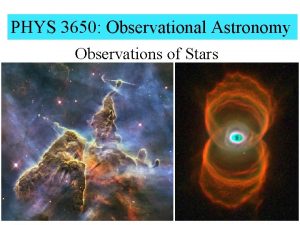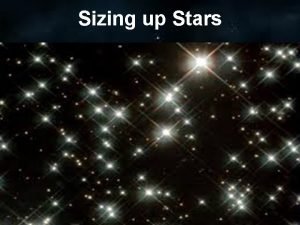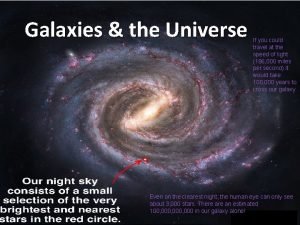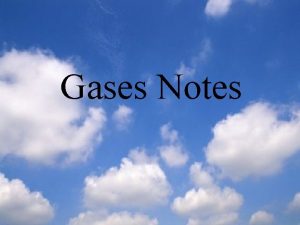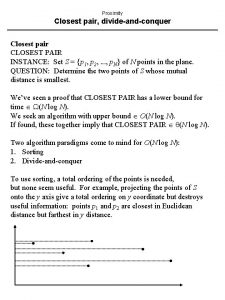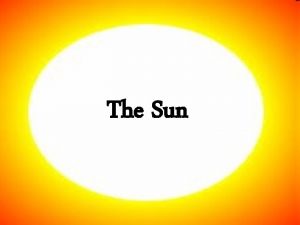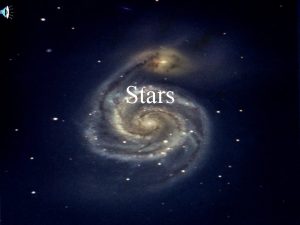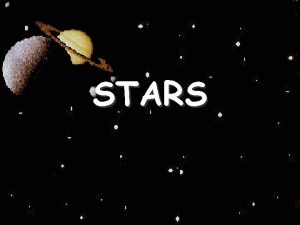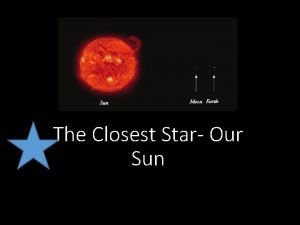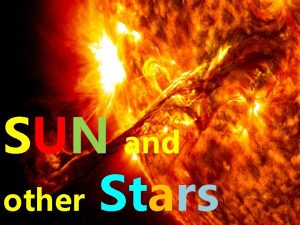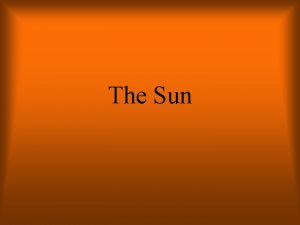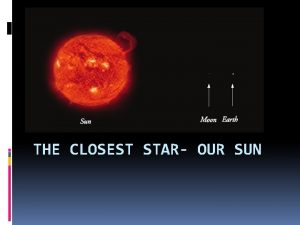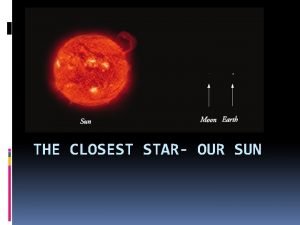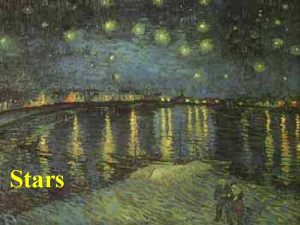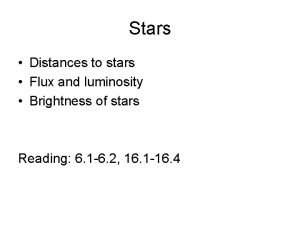Stars Our Sun Distances to stars The Closest














- Slides: 14

Stars & Our Sun

Distances to stars The Closest star to Earth is our Sun (150 million km away) Next closest is Alpha Centauri (40 Trillion km) Light year: distance light travels in one year Light travels at 300, 000 km per sec Takes 8 min. for Sunlight to reach Earth 1 light year = 9. 5 trillion km Travelling at the Speed of Light… Earth to the Sun = about 8 min. Earth to Pluto = about 5. 5 hrs. To next Solar System = 4 years To edge of Galaxy = 5000 years To next Galaxy = 50, 000 years To next Culuster = 500, 00 years

Physical Properties of Stars vary greatly in many ways: size, heat, density, color, etc. • • • White dwarfs: smallest, and very hot (over 30, 000 0 C) Red Giants: larger, and cooler (3, 000 0 C) Main Sequence: average size, and temp. (6, 000 0 C) Super giants Giants Main Se quence Our sun

Elements in Stars • Stars are mainly Hydrogen (H) and Helium (He) • The stars energy comes from Fusion – Fusion: two smaller atoms joining to form a larger one – 2 hydrogen’s fuse forming helium and energy

Types of Stars • Stars are grouped by size and color (temperature) – Giants (usually Red = cooler, can be blue = hotter) – Super Giants (any color) – Dwarfs (any color, sometimes white) • Some stars change intensity in cycles – Variable stars: • Pulsating stars- Brighten and dim (unstable) • Eclipsing binary- one star causes another to dim – Pulsars: the remains of a neutron star giving off faint light pulses

Life of a Star • Nebula- A very large cloud of gas and dust in space – Diffuse nebula: brightly colored – Dark nebula: black in appearance Horse head nebula (dark) Great nebula (diffuse) – Nebulas can either expand out ward and break up or begin to condense and form a protostar

Protostars • Gravity between particles begins to pull them together • Friction and compression increases the temperature • Hot gas begins to glow • Heating and contracting continue until fusion begins • A Star is born! Formation of a Giant • After the hydrogen is used up, stars become unstable • Stars begin to expand cool down • The center begins to fuse Helium into heavier elements • The star can continue to expand, forming a supergiant

White Dwarfs • • • Once a Giant gets too big to support itself implosion The collapse shrinks the star to the size of the Earth Dwarfs are very dense, and give off only faint light The core is mostly Iron If a Dwarf flairs up, it becomes a nova Supernovas • Fusion in a Dwarf stops and the iron core collapses • Core pressure and temperature drastically increase • The core explodes violently • Bright light and dust radiates from the center

Super Red Giant Protostar Nebula White dwarf Red Giant Supernova

Neutron Stars and Black Holes • Forms from the remaining material after a supernova • The gravity is extremely intense • Electrons and protons fuse together forming a center of pure neutrons • Core compresses to about 10 km (extremely dense) • Appear as a tiny black dot • Black Holes occur when a neutron star implodes • A gravity well forms which is so strong, not even light can escape

Our Sun • • • Our sun is average size, temperature, density, and age Like any star it is a ball of Hydrogen and Helium It’s about 110 times bigger than the Earth Surface Temp. = 5, 500 0 C (15, 000 0 C at core) It takes sunlight 8. 33 min. to get to Earth It takes 25 Earth days for the sun to rotate The Sun’s Atmosphere • Made up of 3 regions Photosphere: bright yellow surface (about 400 km thick) Made up of light and dark spots called Granules are actually convection currents of hot gas Chromosphere: Sun’s upper atmosphere (invisible to the eye) Corona: Sun’s outermost atmosphere Solar Prominences (Flares) occur in the corona

Parts of the Sun

Sunspots • • • Sunspot Dark patches on the Photosphere Vary greatly in size and duration Have two areas: Umbra (center) and Penumbra (outside) Occur in pairs due to cooling Sunspots follow an 11 year cycle (none to over 100 at once) Solar Winds and Flares Solar Flare • Solar winds: constant charged particles stream from the Corona – Coronal holes: large “tears” releasing large amounts of Solar winds • Solar flares (AKA Prominences): large plumes of Coronal gas caused by sunspot instability

Magnetic Storms • Occur on Earth due to Solar flares and Coronal holes • Have many affects: – Interrupts TV, Radio, and Telephone reception (Static) – Causes Auroras: Northern and Southern lights – If strong enough, causes electrical surges and power outages Aurora Borealis (Northern Lights)
 There are three sizes of schnauzer dog
There are three sizes of schnauzer dog Scale sun compared to other stars
Scale sun compared to other stars Sun is a star
Sun is a star Augustus waters death
Augustus waters death Symbolism in the fault in our stars
Symbolism in the fault in our stars The fault in our stars doc
The fault in our stars doc The fault in our stars book report
The fault in our stars book report Favourite tv channel
Favourite tv channel Are the stars we see at night in our galaxy
Are the stars we see at night in our galaxy Ted likes to run long distances
Ted likes to run long distances Easterlies and westerlies
Easterlies and westerlies Navigation using speed, distance and time calculations
Navigation using speed, distance and time calculations Gas particles are separated by relatively large distances
Gas particles are separated by relatively large distances It is the distance covered per unit of time
It is the distance covered per unit of time Images of weather systems on television come from
Images of weather systems on television come from

